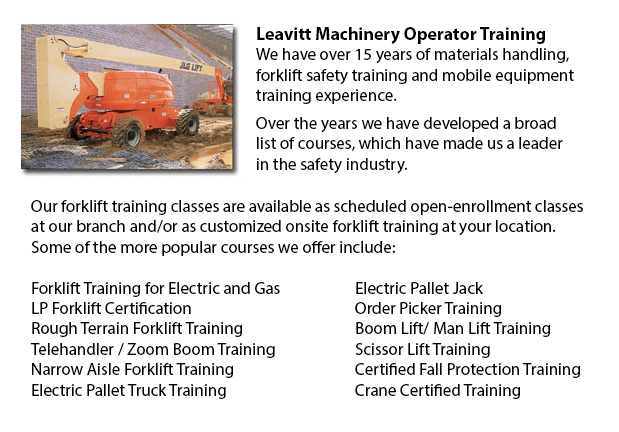
Coquitlam Aerial Boom Lift Training - Aerial Boom Lift Training is needed for any person who operates, supervises or works in the vicinity of boom lifts. This type of aerial lift or aerial work platform is utilized for lifting individuals, materials and tools in projects requiring a long reach. They are normally used to access other above ground job-sites and utility lines. There are different kinds of aerial booms lifts, such as extension boom lifts, cherry pickers and articulating boom lifts. There are two kinds of boom lift: "telescopic" and "knuckle".
Boom lift training is essential and typically involves the basic safety, operations and equipment concerns. Employees are required when working with mobile machines to understand the safe work practices, rules and dangers. Training program materials offer an introduction to the terminology, uses, skills and concepts needed for workers to obtain experience in operating boom lifts. The material is aimed at workers, machine operators and safety experts.
This training is cost-effective, educational and adaptive for your business. An effective and safe workplace can help a company attain overall high levels of production. Less workplace accidents happen in workplaces with strict safety policies. All machine operators should be trained and evaluated. They need knowledge of present safety measures. They should comprehend and follow guidelines set forth by the local governing authorities and their employer.
It is the responsibility of the employer to ensure that workers who are required to make use of boom lifts are trained in their safe use. Every different type of workplace equipment requires its own machine operator certification. Certifications are available for aerial work platforms, articulating booms, scissor lifts, industrial forklift trucks, et cetera. Completely trained employees work more effectively and efficiently compared to untrained personnel, who need more supervision. Correct instruction and training saves resources in the long run.
The best prevention for workplace fatalities is right training. Training could help prevent electrocutions, falls and tip overs or collapses. Other than getting the needed training, workplace accidents could be better prevented by using the aerial work platforms according to the manufacturer's instructions. Allow for the total weight of the worker, tools and materials when following load limits. Never override electrical, hydraulic or mechanical safety devices. Workers must be held securely inside the basket making use of a body harness or restraining belt with an attached lanyard. Do not move lift equipment when workers are on the elevated platform. Workers should be careful not to position themselves between the joists or beams and basket rails in order to prevent being crushed. Energized overhead power lines must be at least 10 feet away from the lift machinery. It is suggested that employees always assume power lines and wires might be energized, even if they seem to be insulated or are down. If working on an incline, set brakes and use wheel chocks.
-
Coquitlam Crane Certification
Coquitlam Crane Certification - The Crane Certification training program consists of subject matter recommended by industry concerning the safe and efficient operation of cranes. Trainees will be taught the following: how to identify cranes and their... More -
Coquitlam Crane Training Courses
Coquitlam Crane Training Courses - A crane is a kind of equipment designed to move, lift and lower heavy stuff. A crane is usually equipped with a hoist, sheaves, and chains or wire ropes. Cranes are used in the manufacturing, construction and transp... More -
Coquitlam Boom Lift Safety Training
Coquitlam Boom Lift Safey Training - Boom lifts are a kind of elevated work platform or aerial lifting device which are usually used in industry, warehousing and construction. Boom lifts can be utilized in virtually any setting due to their versatili... More -
Coquitlam Boom Lift Training
Coquitlam Boom Lift Training - Aerial platforms or also known as elevated work platforms are devices which allow workers to carry out duties and tasks at elevated heights that would not be otherwise reachable. There are different aerial lifts availab... More -
Coquitlam Forklift Certification Schools
Coquitlam Forklift Certification Schools - Forklift Certification is mandatory within North America. Hence, forklift training programs are important both for businesses and for people looking for jobs in industries as operators of forklifts. Forklift... More -
Coquitlam Wheel Loader Training
Coquitlam Wheel Loader Training - Normally, the different types of heavy equipment training are divided into 2 categories of equipment: those that have rubber tires and tracked vehicles. Tracked vehicles include items like for instance bulldozers, ex... More -
Coquitlam Heavy Equipment Training Schools
Coquitlam Heavy Equipment Training Schools - There are a lot of heavy equipment training schools to choose from. If you would like to get to the best, it is important to examine several factors of the school to be able to determine the level of educa... More -
Coquitlam Telehandler Training Courses
Coquitlam Telehandler Training Courses - Employers are responsible for making sure that their supervisory and operating personnel are trained to work proficiently making use of telehandler equipment. The skill level of workers should be assessed. If... More

Forklift Certification Coquitlam
TOLL FREE: 1-888-254-6157
Coquitlam, British Columbia
forkliftcertificationcoquitlam.com
Email Us
About Us


